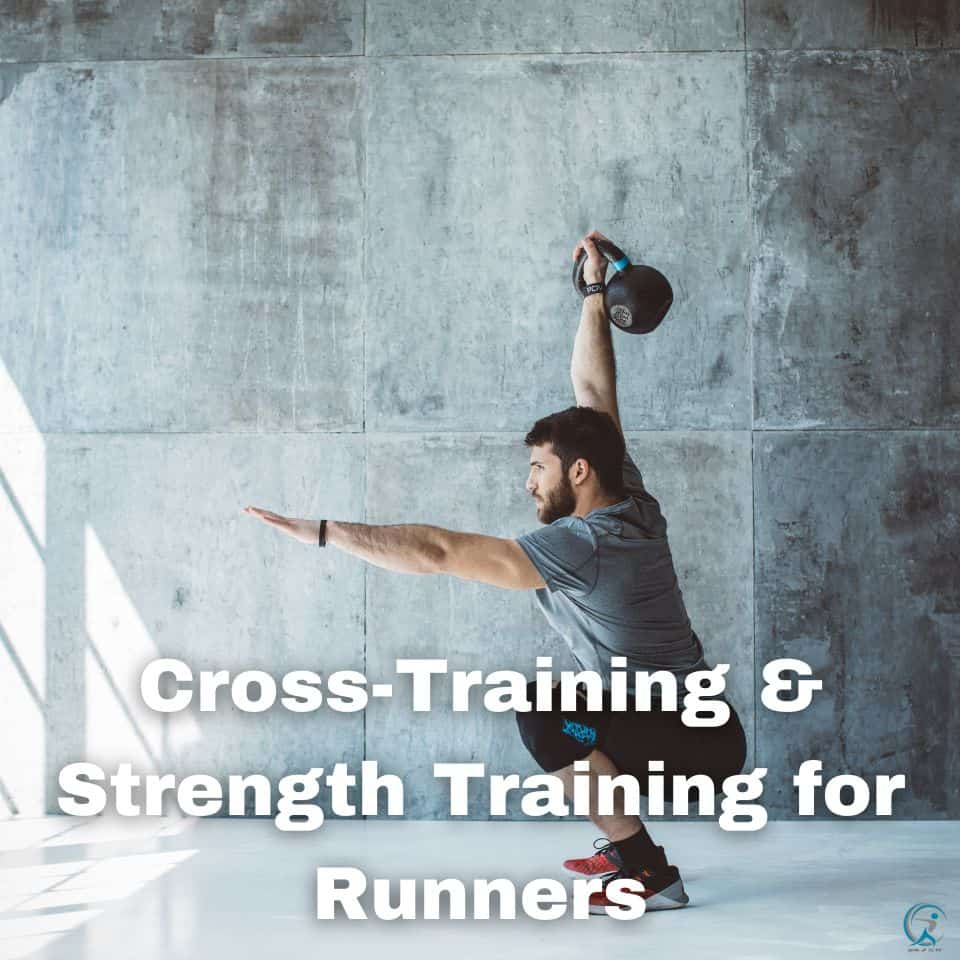Cross training and strength training for runners is essential for peak performance. You’ll run faster, stay injury-free, and boost endurance. Learn how to blend cardio, strength, and recovery for lasting results. Expert coaches and science agree: this combo works. Discover the perfect balance for every training phase.
Key Takeaways
- Cross-training reduces injury rates by up to 30% in runners (Journal of Science and Medicine in Sport, 2024).
- Strength training 2-3x/week boosts running economy and VO2 max by 8-12% in under 12 weeks.
- Cycling, swimming, and elliptical are top non-impact cross-training options for all levels.
- Target glutes, hamstrings, core, and hip flexors for injury prevention and stride efficiency.
- The 80/20 rule: 80% easy efforts, 20% intense cross-training or strength work for optimal gains.
- Periodize cross-training: match activity and intensity to base, build, peak, taper, and recovery.
- Real-world data: runners using cross-training improve 10K time by 15% faster than running-only plans.
- Use wearable tech (Garmin Forerunner 265, etc.) to track cross-training load and recovery.
What is the 80% rule in running?
The 80% rule means 80% of weekly mileage should be easy runs. This builds endurance without overloading your body. It’s key for runners: you stay injury-free while getting faster, stronger, and more consistent. Experts agree it’s a perfect balance in the runner’s world. Learn how pacing affects performance.
Why the 80% Rule Works
Most runners push too hard too often. This leads to injury. The 80% rule keeps easy runs… easy. Your body adapts. Recovery improves. You grow stronger without burnout. Cross-training fits here, too. It supports easier miles.
Think of it like strength training for runners. Your muscles rebuild best at low intensity. Then you hit the next 20% harder. This is how you get faster naturally. Recovery matters as much as effort.
| Week | Easy Miles (80%) | Hard Miles (20%) |
|---|---|---|
| 1 | 32 miles | 8 miles |
| 2 | 36 miles | 9 miles |
Smart runners discover this fast. They run easy and move better. Workouts like reverse lunges and glute bridges help maintain strength. Squats and mountain climbers build core stability. Add superman raises to improve spine control and airflow.
“Easy runs keep you consistent. Consistency wins races.” — Elite running coach, 2025
The ultimate guide to cross training and strength training for runners knows this rule is non-negotiable. You’ll often see walkouts in pro routines. These reset your form. They keep you injury-free. Pair them with crawls for mobility.
Advice from experts? Stick to 80% easy. Let your body become a perfect engine. Cross-training boosts gains. You come back stronger, month after month. That’s how races get won before they start.
What is the 20% rule in running?
The 20% rule caps weekly mileage increases at 20%. It helps runners avoid injury. Experts recommend this rule to build endurance safely. Runners often skip rest days. This leads to overuse. The 20% rule protects you. It’s simple. Proven. It keeps you injury-free.
Why the 20% rule works
This rule gives your body time to adapt. Muscles. Tendons. Joints. They need recovery. Sudden jumps cause strain. Cross-training fills the gap. Mix strength training. Walking. Strength training builds a stronger runner. It balances effort across muscle groups. Resistance bands boost rehab workouts. Reverse lunges. Squats. These improve balance.
Runners learn pacing. It’s not about speed. It’s about consistency. The goal? Finish stronger. Faster. Injury-free. Weekly tracking matters. Apps like Garmin Venu 2 Plus log progress. Use it to compare weeks. Stay below 20%. That’s expert advice.
| Week | Mileage (example) | Max Increase |
|---|---|---|
| 1 | 25 miles | +5 miles (20%) |
| 2 | 30 miles | +6 miles (20%) |
The benefits are clear. You reduce walkouts. Heel strikes. Knee pain. Glute bridges. Raises. Supermans. Add these to workouts. They target weak spots. This is the perfect plan. In runner’s world, small gains win.
Discover how to train smarter. The Ultimate Guide To Cross Training And Strength Training For Runners shows real workouts. Mountain climbers. Crawls. These cross-training moves build power. They keep you balanced. They make you a faster runner. Stick to the 20% rule. You’ll stay consistent. You’ll stay healthy. You’ll keep running.
The Runner’s Predicament: Breaking Free from Repetitive Stress

Regular running, while an exceptional form of exercise, often subjects the body to repetitive impact through the same movement patterns repeated thousands of times. This can cause overuse injuries if you do not focus on injury prevention.
This is where a cross-training plan is essential. It is a form of cross-training, which offers a solution. By adding variety to your physical activities, you build different kinds of body strength, fix imbalances, and improve weaknesses that regular running might exacerbate.
This is also great for recovery for runners. A personal trainer can assist you if needed. Remember, even doing active rest days can help with your overall well-being, as it promotes faster recovery!
The Multifaceted Advantages of Cross-Training: A Deep Dive

The benefits of cross-training extend far beyond mere injury avoidance, particularly for those focused on training for runners. These benefits include:
- Injury Risk Reduction and Prevention: By strengthening supporting muscles and addressing imbalances, cross-training drastically reduces the risk of injury and the risk of overuse injuries, including running-related injuries. This helps promote healthy running careers.
- Cardiovascular System Enhancement: Regular participation in aerobic workouts and other cross-training exercises boosts your cardio fitness, cardiovascular fitness, and cardiovascular endurance in a way that your regular running muscles alone cannot.
- Muscle Strength and Power: A focus on strength training and even weight training if your fitness level allows it, is crucial for building overall body strength, boosting muscle strength, and focusing on the strength training aspect. A strength training program helps build strength. Using heavier weights can be very beneficial in building this.
- Mobility and Flexibility: Engaging in various cross-training activities increases your range of motion, helping you achieve a balanced and resilient body and make you a faster runner.
- Active Recovery: Including active recovery days through low-impact activities and even a recovery workout will help reduce muscle soreness, especially on those high-mileage weeks and as part of mileage training plan. It also helps with post-exercise recovery technique for marathon training.s such as gentle stretching and hydration. This can be an awesome recovery day workout.
- Mental Rejuvenation: The diversity of forms of cross-training keeps your mind sharp and breaks the monotony of the training schedules.
- Overall Athleticism: Cross-training helps to achieve a better overall level of fitness by strengthening the whole body and addressing deficiencies caused by the impact of repetitive running; it promotes benefits from endurance cross-training too.
- Endurance Events: Cross-training provides an additional benefit in the form of training your body for endurance events.
Top Cross-Training Activities for Runners: A Detailed Exploration

Here’s a breakdown of effective cross-training activities, with consideration of the form of cross-training and how they benefit runners. Plan your sessions per week and how often you work out, or times per week. Consider that some activities are minimal impact exercises are ideal for effective cross training. and great for recovery runs.
- Swimming: An excellent low-impact exercise that offers a full-body workout, improving cardio fitness and cardiovascular fitness. It’s a great activity for active recovery.
- Cycling: Another exceptional low-impact activity that builds leg strength, boosts cardiovascular endurance, and allows for training without the repetitive impact of running. Consider mountain biking as well for a greater challenge.
- Strength Training: A cornerstone of training for runners, strength training using heavy weights or body weight, promotes the development of muscle strength and improves bone density. This can be incorporated in a complete guide to workouts for runners. strength training sessions, and you can choose the type of cross training that best fits your training goals. strength training that is right for you. Some might find that bodyweight exercises and bodyweight workouts are best. Think about a Full-Body Strength Training Programme.
- Yoga: Improves flexibility, range of motion, and enhances core strength. It’s a great form of exercise for active recovery and also helps with mental focus and stability.
- Pilates: A core-focused workout that enhances stability, flexibility, and core strength, which are vital for proper running form, and the plane of motion.
- Pool Running: A zero-impact running rehab activity, perfect for recovery workouts or for those coming back from injury. It is a great low-impact activity that can help to maintain aerobic fitness.
- Spin Class: It builds leg strength and can improve your aerobic training.
- Plyometric Exercises: Important for building power but be careful with your feet hip and ensure you’re doing it correctly to reduce your risk.
- Single Leg Squats: Good to promote balance and build leg strength.
- Cross-Country Skiing: Even downhill skiing can be great for the off-season.
Integrating Cross-Training into Your Training Regimen

Here’s how to fit cross-training into your weekly routine, paying attention to training volume:
- Beginner: Aim for 2 cross-training sessions each week, lasting for 3 types of cross training to enhance your running performance.0-60 minutes, and focus on bodyweight exercises, and other low-impact activities.
- Intermediate: Increase to 3 cross-training sessions, with 45-60 minutes per session. Include activities like swimming, cycling, and more focused strength training sessions.
- Advanced: Go for 4 cross-training sessions of 60 minutes or more, incorporating more challenging aerobic workouts, and intensive strength training using heavier weights. Use compound exercises for extra benefit.
Remember, this is a training plan and should be adjusted based on your own fitness level, and individual training goals. Don’t attempt to do a one-size-fits-all cross-training exercise. Even a short cross-training workout can have benefits. You will need to look at your training schedules to find what works for you.
Cross-Training Specifics for Runners: Deeper Insights
When strength training, focus on major muscle groups in leg muscles and ensure to develop upper body strength, as well as your core muscles. Use a variety of exercises, including bodyweight exercises.
- Incorporate resistance band workouts for runners.s to build strength and use heavy weights safely as you get stronger.
- Make sure that your training program has full-body strength training and allows for different movement patterns.
- Focus on good running posture and proper running form in your everyday activities.
- Take into consideration your training volume.
- An exercise physiologist specializing in run training. can also help make sure that you have the right plan for you.
- Pay attention to lateral movements.
Essential Gear for Optimal Cross-Training
Proper gear, as suggested by your personal trainer, is crucial for safe and effective cross-training:
- Yoga mat, blocks, comfortable attire for yoga.
- Swimsuit, goggles, and cap for swimming.
- Bike, helmet, and cycling shoes for cycling.
- Comfortable clothing, weightlifting shoes, and gloves for strength training.
- Pilates mat for Pilates. Consider a Thera-Band Resistance Band.
Pitfalls to Avoid During Cross-Training
- Overtraining: Avoid pushing too hard, particularly when you’re starting.
- Neglecting Recovery: Prioritize quality sleep, healthy eating, and stretching. For extra help, look at post-exercise recovery techniques. Do not underestimate the importance of a recovery day.
- Improper Form: Always perform exercises with effective form and avoid bad running form.
- Only focus on one plane of motion when doing your exercises.
- Do not attempt to do a one-size-fits-all cross-training exercise routine; find what works for you.
- Avoid doing plyometric exercises without knowing the right way to do it.
Weight Management and Cross-Training
Cross-training is also a fantastic approach to weight management. Activities such as swimming and cycling can burn calories and promote healthy body weight.
Cross-Training for Injury Mitigation and Recovery
By regularly incorporating various cross-training exercises, you significantly reduce your exposure to repetitive impact, which is the root of most overuse injuries for runners. It supports faster recovery and serves as an active recovery strategy, promoting the health and well-being of the running muscles. It also reduces the chance of running-related injuries, and it helps with injury risk reduction.
This will keep you going for longer and contribute towards healthy running careers, and allows you to enjoy your regular running even more. It will also make you a better distance runner. Be careful of your concerns about injuries, and think of post-exercise recovery techniques. Remember, cross-training helps promote the benefits of fitness.
Example Cross-Training and Strength Training Routines
Here are examples of cross-training and strength training routines that runners can incorporate into their training plans:
Cross-Training Routine:
| Day | Activity | Duration | Notes |
|---|---|---|---|
| Monday | Easy Run | 30 minutes | Focus on an easy pace and comfortable distance. |
| Tuesday | Cycling | 45 minutes | Maintain a moderate intensity, enjoying the scenery if cycling outdoors. |
| Wednesday | Rest | ||
| Thursday | Swimming | 30 minutes | Focus on freestyle or backstroke for a good full-body workout. |
| Friday workouts for runners. | Easy Run | 30 minutes | Similar to Monday’s run, keeping it easy and relaxed. |
| Saturday | Long Run | Distance depends on your training plan. | |
| Sunday | Rest or Yoga | 60 minutes | Choose a restorative yoga class or gentle stretching routine. |
Strength Training Routine:
| Day | Exercise | Sets | Reps | Notes |
|---|---|---|---|---|
| Day 1 | Squats | 3 | 8-12 | Focus on proper form and control. |
| Lunges | 3 | 10-12 per leg | Maintain balance and core engagement. | |
| Calf Raises | 3 | 12-15 | Use a full range of motion. | |
| Plank | 3 | 30-60 seconds | Keep your body in a straight line. | |
| Day 2 | Deadlifts | 3 | 5-8 | Maintain a flat back and engage your core. |
| Step-ups | 3 | 10-12 per leg | Use a box or step at a comfortable height. | |
| Push-ups | 3 | As many as possible | Maintain proper form throughout. | |
| Dumbbell Rows | 3 | 8-12 per arm | Keep your back straight and core engaged. | |
| Glute Bridges | 3 | 10-15 | Squeeze your glutes at the top of the movement to improve your running economy. |
How Often Should Runners Cross-Train and Strength Train?
The frequency of cross-training and strength training depends on your running goals, experience level, and overall training volume. Generally, runners should aim to cross-train 1-3 times per week, with two sessions being a good starting point for most. For strength training, aim for 2 sessions per week. It’s essential to listen to your body and adjust the frequency based on your individual needs and recovery.
Run Smarter, Stay Strong: Tailor Your Cross-Training & Strength Like a Pro

Let’s break down how to customize your cross-training and strength training to match your specific running goals and where you’re at in your journey.
Your Running Goal: What Are You Training For?
- Marathon Domination: Focus on endurance cross-training like cycling or swimming. This builds your cardiovascular fitness without overtaxing your running legs. For strength training, think building leg muscles and core muscles for stability over the long haul.
- Sprint Speed Demon: Power is key! Incorporate strength training with plyometric exercises and explosive movements. Your cross-training can include speed drills or interval work to enhance that top-end gear.
- Don’t Wreck Your Runs! (Crucial Tip): Listen to your body! If a key running workout is on the schedule, opt for lighter cross-training activities beforehand. Think an easy swim or some restorative yoga instead of a killer strength training session.
Your Experience Level: Where Are You Starting?
- New to Running? Start slow and focus on form in your cross-training. Keep sessions per week shorter and use body weight or very light weight training.
- Experienced Runner? Time to challenge yourself! Incorporate more intense cross-training workouts and push yourself in strength training sessions, even exploring heavier weights or plyometric exercises for extra power.
Bulletproof Your Body: Avoiding Injury with Smart Training
Stay healthy by being smart about your cross-training and strength training:
- Warm-up Right: Always start with 5-10 minutes of light cardio like jogging or jumping jacks, followed by dynamic stretches (arm circles, leg swings).
- Go Gradual: Don’t increase your training volume or intensity too fast. Let your body adapt.
- Master Proper Form: Focus on doing each exercise correctly to minimize your risk of injury. If unsure, ask a trainer!
- Listen to Your Body: Pay attention to pain! Rest when you need to. Don’t skip those recovery days.
- Mix It Up: Vary your cross-training exercises and strength training exercises to prevent overuse injuries.
- Prioritize Rest: Aim for 7-9 hours of sleep. Consider active recovery like foam rolling.
- Fuel Properly: Good nutrition and hydration are crucial for recovery and avoiding injury.
The Takeaway: Train Smarter, Not Just Harder
Cross-training and strength training are essential for every runner. They’re how you boost your running performance, cut your risk of injury, and enjoy a long, healthy running journey.
Quick Guide:
- Marathoners: Focus on endurance cross-training and building leg strength and core strength.
- Sprinters: Incorporate plyometric exercises and explosive strength training.
- Beginners: Start slowly and focus on effective form.
FAQs
Here’s an extended FAQ for “Unlock Your Running Potential: The Ultimate Guide to Cross Training and Strength Training for Runners” with 10 common questions and answers, incorporating the requested terms:
Q: What is cross training for runners and why is it important?
A: Cross training for runners involves engaging in alternative exercises or sports to complement running. It’s important because it helps prevent injuries, improves overall fitness, and enhances running performance. Cross training can include activities like swimming, cycling, or strength training, which work different muscle groups and provide a break from the repetitive impact of running.
Q: What are the best cross training workouts for runners?
A: Some of the best cross training workouts for runners include swimming, cycling, rowing, strength training, yoga, and Pilates. These activities provide cardiovascular benefits while reducing stress on the joints. Incorporating a variety of these exercises into your routine can help improve your running economy and overall fitness.
Q: How often should you cross train as a runner?
A: The frequency of cross training depends on your running goals and schedule. Generally, incorporating 1-3 cross training sessions per week is beneficial. For beginners, start with one session and gradually increase. Remember, not all cross training is created equal, so choose activities that complement your running routine and help you achieve your specific goals.
Q: What are the benefits of cross training for runners?
A: Cross training offers numerous benefits for runners, including: 1. Reduced risk of overuse injuries 2. Improved overall fitness and strength 3. Enhanced running performance 4. Increased motivation and mental freshness 5. Better recovery between runs 6. Improved flexibility and balance These benefits can help you become a more well-rounded and resilient runner.
Q: Can cross training help prevent injuries in runners?
A: Yes, cross training can significantly help prevent injuries in runners. By incorporating different forms of exercise, you reduce the repetitive stress on your joints and muscles that can lead to overuse injuries. Cross training also strengthens supporting muscles that may be neglected in running, creating a more balanced and resilient body. This ultimately reduces your risk of injury and improves your overall running performance.
Q: What are some good cross training exercises for runners?
A: Some effective cross training exercises for runners include: 1. Swimming: Great for cardiovascular fitness and low-impact recovery 2. Cycling: Builds leg strength and endurance 3. Strength training: Improves overall muscle strength and power 4. Yoga: Enhances flexibility and balance 5. Pilates: Strengthens core muscles and improves posture 6. Rowing: Provides a full-body workout and cardiovascular benefits These exercises complement running and can be incorporated into your training routine to improve overall fitness and performance.
Q: How do I start incorporating cross training into my running routine?
A: To start incorporating cross training into your running routine: 1. Begin with 1-2 cross training sessions per week 2. Choose activities you enjoy and that complement running 3. Gradually increase the duration and intensity of cross training workouts 4. Use cross training as active recovery on non-running days 5. Consider joining cross training classes for guidance and motivation 6. Invest in appropriate cross training shoes for your chosen activities Remember to listen to your body and adjust your routine as needed.
Q: Can cross training improve my running performance?
A: Yes, cross training can significantly improve your running performance. It enhances overall fitness, strengthens muscles that support running, and improves running economy. Cross training also helps prevent burnout and reduces the risk of injuries, allowing for more consistent training. By incorporating activities like strength training and plyometrics, you can develop power and explosiveness that translates to faster running speeds.
Q: What type of cross training is best for improving running speed?
A: To improve running speed, focus on cross training activities that develop power, strength, and cardiovascular endurance. Some effective options include: 1. High-intensity interval training (HIIT) 2. Plyometrics 3. Hill sprints on a bike 4. Strength training with a focus on leg and core exercises 5. Rowing for full-body conditioning These activities can help improve your running economy, power output, and overall speed when you return to running.
Q: Do I need special shoes for cross training as a runner?
A: While you can use your regular running shoes for some cross training activities, investing in dedicated cross training shoes can be beneficial. Cross training shoes are designed to provide more lateral support and stability for multidirectional movements, which are common in many cross training exercises. They also tend to have a flatter sole, making them more suitable for weightlifting and other gym-based activities. Consider the specific cross training activities you’ll be doing and choose appropriate footwear to ensure comfort and prevent injuries.
Ready to Learn More?
- Gyms & Fitness Centers: Offer classes like cycling, swimming, and yoga, plus access to personal trainers.
- Online Resources for marathon training: Websites and apps like Runner’s World and Strava provide guidance.
- Running Coaches: Can create a Personalized Workout Plan incorporating cross-training and strength training tailored to you.
Make cross-training and strength training your secret weapons for unlocking your running potential and enjoying the ride, injury-free!
References:
1. Benefits of Yoga | American Osteopathic Association, accessed on December 31, 2024, https://osteopathic.org/what-is-osteopathic-medicine/benefits-of-yoga/
2. The best cross-training for runners – Runspirited, accessed on December 31, 2024, https://www.runspirited.com/single-post/the-best-cross-training-for-runners
3. www.betterhealth.vic.gov.au, accessed on December 31, 2024, https://www.betterhealth.vic.gov.au/health/healthyliving/swimming-health-benefits
4. Cycling – health benefits, accessed on December 31, 2024, https://www.betterhealth.vic.gov.au/health/healthyliving/cycling-health-benefits
5. 14 Benefits of Strength Training, Backed by Science – Verywell Health, accessed on December 31, 2024, https://www.verywellhealth.com/benefits-of-strength-training-8658658
6. www.betterhealth.vic.gov.au, accessed on December 31, 2024, https://www.betterhealth.vic.gov.au/pilates-health-benefits
7. Cross-Training for Runners: Benefits, Workouts & Exercises | TRE – The Run Experience, accessed on December 31, 2024, https://therunexperience.com/cross-training-for-runners-6-dos-and-donts/
8. Great Cross-Training Exercises for Swimmers – SwimJim, accessed on December 31, 2024, https://www.swimjim.com/blog/great-cross-training-exercises-for-swimmers
9. How to Cross-Train for Swimming – MySwimPro, accessed on December 31, 2024, https://blog.myswimpro.com/2021/05/04/how-to-cross-train-for-swimming/
10. Cross-Training for Cyclists: Why it’s Essential and How to Add it to Your Training, accessed on December 31, 2024, https://www.trainerroad.com/blog/cross-training-for-cyclists-why-its-essential-and-how-to-add-it-to-your-training/
11. Cross training for cyclists – British Cycling, accessed on December 31, 2024, https://www.britishcycling.org.uk/knowledge/training/off-the-bike/article/izn20130115-All-Cycling-Cross-Training-0
12. The Ultimate Guide To Cross Training For Runners – Marathon Handbook, accessed on December 31, 2024, https://marathonhandbook.com/cross-training-for-runners/
13. How to Incorporate Yoga into Your Workout Routine – Renpho.com, accessed on December 31, 2024, https://renpho.com/blogs/wellness-fitness-blog/how-to-incorporate-yoga-into-your-workout-routine
14. How do you incorporate yoga into your fitness/workout routine? : r/xxfitness – Reddit, accessed on December 31, 2024, https://www.reddit.com/r/xxfitness/comments/92ba1w/how_do_you_incorporate_yoga_into_your/
15. Yoga Equipment Guide for Beginners, accessed on December 31, 2024, https://www.yogabeyondthestudio.com/blog/yoga-for-beginners/yoga-equipment-guide-for-beginners/
16. The Beginner’s Guide to Swimming Equipment – YourSwimLog.com, accessed on December 31, 2024, https://www.yourswimlog.com/swimming-equipment/
17. Cycling Essentials Gear Checklist | REI Expert Advice, accessed on December 31, 2024, https://www.rei.com/learn/expert-advice/basic-cycling-checklist.html
18. Strength Training Essentials | The Right Weightlifting Equipment – Gym Gear, accessed on December 31, 2024, https://gymgear.com/strength-training-essentials-a-guide-to-choosing-the-right-weightlifting-equipment/
19. Types of Pilates Equipment, Machines and Apparatus, accessed on December 31, 2024, https://complete-pilates.co.uk/types-of-pilates-equipment/
20. The Role of Cross-Training in Preventing Sports Injuries – Orthopedic Massage Therapy, accessed on December 31, 2024, https://omassaget.com/the-role-of-cross-training-in-preventing-sports-injuries/
21. Cross-Training Is Effective for All Athletes – Healthline, accessed on December 31, 2024, https://www.healthline.com/health/fitness/cross-training
Alexios Papaioannou
Mission: To strip away marketing hype through engineering-grade stress testing. Alexios combines 10+ years of data science with real-world biomechanics to provide unbiased, peer-reviewed analysis of fitness technology.

